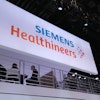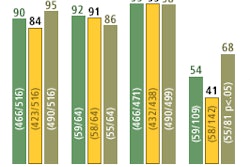LOS ANGELES - Between bone marrow and metallic implants, diagnosing chronic orthopedic infections in the central skeleton (COICS) is a tricky business. Investigators from two branches of Ghent University Hospital in Ghent and Aalst, Belgium, tested Infecton SPECT and FDG-PET for these diseases and found that each modality had its strengths and weaknesses.
"When we talk about osteomyelitis, we have to make a clinical difference between acute infections and chronic infections. Acute infections are usually hematogeneous, and this poses few diagnostic problems. If we need imaging, we can use MRI or a bone scan," said Dr. Frederic de Winter during his talk Tuesday at the 2002 Society of Nuclear Medicine meeting.
Bone scans are both highly sensitive and specific for acute infection. However, in the case of chronic osteomyelitis, which is usually post-traumatic or post-surgical, the role of nuclear medicine is much more important because bone scans are non-specific, de Winter said.
"We needed to increase our specificity," he said. "Scintigraphy and FDG-PET are promising techniques due to low bone marrow uptake."
The patient population consisted of 52 patients with COICS. They were prospectively evaluated with 99mTc-ciprofloxacin (Infecton) SPECT and FDG-PET. In all but 5 patients, a complete microbiological or clinical diagnosis was obtained. To avoid selection bias, patients with recent surgery were not excluded, de Winter said.
Infecton SPECT was performed on an Irix triple-head gamma camera (Philips Nuclear Medicine, Milpitas, CA), three hours after the injection of 370 MBq of 99mTc-ciprofloxacin (20 steps over 6° of 60 seconds each). PET was performed 60 minutes after an injection of 370 MBq FDG on an ECAT 951/31 scanner (Siemens Medical Solutions - Nuclear Medicine Group, Hoffman Estates, IL). Scanning was done at a minimum of eight minutes per bed position with no attenuation correction.
Two readers blinded to the results ranked the images on a five-point scale. A consensus was reached in all cases, de Winter said.
Out of 57 patients, 13 had COICS. FDG-PET proved to be more accurate than Infecton SPECT, turning in true-positive results in all 13 patients, true-negative results in 32 patients, and false-positive results in 7 patients. The sensitivity for FDG-PET was 100%, the specificity was 87%, and the accuracy was 65%.
While the results for Infecton SPECT weren’t as rosy -- 77% sensitivity, 56% specificity, and 79% accuracy -- the fact that it is a lower-cost exam may make it more appealing as a first-line imaging strategy, de Winter.
Both modalities suffered from less than impressive specificity in patients who had been operated on less than six months earlier. When those patients were excluded, the numbers climbed slightly, to 100% sensitivity, 82% specificity, and 94% accuracy for FDG-PET. For Infecton SPECT, both sensitivity and specificity came in at 78%, while accuracy was at 87%.
"So accuracy was in the same range, but FDG-PET was more sensitive. For chronic orthopedic infections, I would prefer FDG-PET when available. Infecton SPECT seems to be a promising alternative," de Winter said.
Researchers from Istanbul University in Turkey had better results with Infecton SPECT. In their study, they compared the modality to 99mTc HMPAO white blood cell scans for COICS. In their study, 56 sites with suspected bone or joint infection were examined in 51 patients, 21 of whom had prosthetic implant materials. For Infecton SPECT, they reported a sensitivity of 94%, a specificity of 83%, and an accuracy of 89%. For the WBC scan, the sensitivity came in at 63%, the specificity at 96%, and the accuracy at 77%.
"Infecton SPECT is a useful agent for detecting infectious foci in bones and joints. Moreover, the Infecton scan seems to be a more powerful tool in diagnosing vertebral infections than WBC scintigraphy," they wrote (Journal of Nuclear Medicine, April 2001, Vol.42:4, pp.567-574).
By Shalmali PalAuntMinnie.com staff writer
June 19, 2002
Copyright © 2002 AuntMinnie.com




















